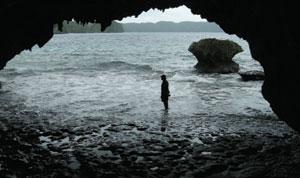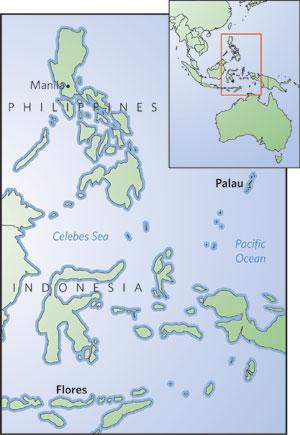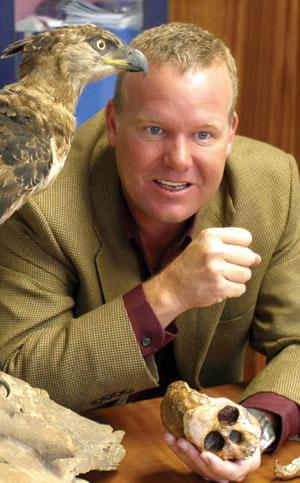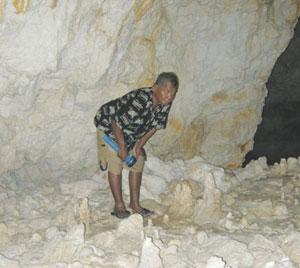
Posted on 04/16/2008 8:06:27 PM PDT by blam
Archaeology: Bones, isles and videotape
Old human remains found on the Pacific islands of Palau are caught in the crossfire between entertainment and science. Rex Dalton reports.

The Palauan caves lie in the 'rock islands' of the archipelago.R. DALTON
Circled by a protective coral reef, the 300-island archipelago of Palau is one of the Pacific Ocean's most biodiverse ecosystems. The first intrepid voyagers who arrived here, more than 3,000 years ago, would have found lush plants and waters teeming with fish and crustaceans. By 2,500 years ago the Palauans were even practising sophisticated agriculture, creating terraces on the archipelago's largest island on which to grow crops.
Given this evidence, many archaeologists were stunned by a report last month that a tribe of small-bodied humans had purportedly lived on some of the islands 1,000–3,000 years ago and possibly suffered dwarfing because of limited resources.
The article1, by palaeoanthropologist Lee Berger of the University of Witwatersrand in South Africa and his colleagues, suggested that the tiny Palauans might help inform the debate over the controversial 'hobbits'. These remains, found on the Indonesian island of Flores, 2,000 kilometres to the south of Palau, are believed by many researchers to represent a distinct dwarf species called Homo floresiensis, which died out 12,000 years ago2,3,4. Berger and his team argue that their Palau find suggests that the hobbits may not be a separate species, as dwarfing can occur in island environments.
But veteran Pacific anthropologists quickly began dissecting the new article. Many of them now hold that the report offers little support for the assertions of a dwarfed tribe. In fact, they say the bones are likely to be from normal-sized island dwellers, possibly juveniles.

“The more I read their paper, the more I am convinced it is complete nonsense and cannot be accepted as serious science,” says Michael Pietrusewsky, an anthropologist at the University of Hawaii at Manoa, who is considered to be the primary authority on Pacific island skeletons. The use of these bones to make assertions about H. floresiensis or other Homo species, he says, “is totally inappropriate”.
Berger responds that such criticism is ill-founded. “Might it be that such critics have not read our manuscript as carefully as is required of a sophisticated debate on human variation before commenting?”, he told Nature in an e-mailed response to questions.
The drama of discovery
To some, the Palau story illustrates how science can get caught up in the entertainment process. Like many palaeoanthropologists, Berger has long worked with film crews to document discoveries. But sometimes the demands to catch a significant finding on tape can clash with the slow, rigorous nature of the scientific process. The question anthropologists are asking now is: did entertainment needs in Palau overwhelm the evidence from field research?
In other areas of his research, Berger has worked on a planned television series featuring him called Fossil Hunter, which uses the slogan “entertainment first, science second”. For the Palau work, he teamed up with a London-based production company, Parthenon Entertainment, to create a film later distributed by the National Geographic Society of Washington DC.
The National Geographic Society awards some $5 million in grants annually to researchers from a number of disciplines — including the popular ones involving human ancestors, dinosaurs or animal stories. For scientists in these fields, small seed grants to pay for field trips are hard to secure, so the society's grants are valued highly and often produce quality research.
But National Geographic is also a non-profit media empire, netting $100 million on revenues of $500 million in 2006. Its editors work to get featured discoveries by its funded researchers into both its flagship magazine and peer-reviewed journals at the same time. This arrangement can sometimes backfire, such as in 2000 when the magazine featured a report on a flying dinosaur fossil that later turned out to be a cleverly faked composite5,6.
Berger's project in Palau provides a behind-the-scenes view of when entertainment and science meet. It is a process that can sometimes leave scientists disgruntled (see 'Caught out on camera'), and can lead to accusations from some communities in developing nations that they have been exploited. For some, what happened in Palau offers examples of some of the pitfalls. “There is something unseemly about how this evolved and was orchestrated,” says William Jungers, a palaeoanthropologist at Stony Brook University in New York.
Paradise place

Fossil hunter: Lee Berger has appeared in several science-related television films.I. TLADI/REUTERS
The tale of the Palau project began in April 2006, when Berger, an American by birth, was on holiday with his family from Johannesburg. With countless channels of placid shallows, coral reefs and more fish than Hawaii, Palau is known worldwide to divers and kayakers. Its jungle has also been used to film the reality television programme Survivor .
On the last day of his trip, Berger says, a guide took him on a kayak trip to a cave called Ucheliungs, which a brochure noted held bones. Venturing inside, Berger nosed around and spotted some remains, including a skull with a prominent brow over the eye sockets — a sure sign of primitive traits.
The island containing the high-domed cave is off-limits to visitors, officials say. Berger later acknowledged that he didn't know the rules at the time. But other researchers, such as Timothy Rieth, an archaeologist at the International Archaeological Research Institute in Honolulu, Hawaii, questioned those steps ashore. A decade ago, Rieth worked on an archaeological assessment of an unrelated Palau project. On a boat trip one day, Rieth viewed the mouth of the other cave studied by Berger, called Omedokel, but didn't venture inside even though bone piles could be seen. “I don't just go inside burial caves on vacation because it's fun,” says Rieth, who was with a Palau cultural official at the time.
Berger has made waves with his research before. In 1995, early in his career in South Africa, he and his Witwatersrand colleague Ron Clarke gained attention for their proposal that the 'Taung child', a 2.5-million-year-old fossil from South Africa, had been damaged by an eagle or other large bird of prey7. Berger still strongly supports this hypothesis: in 2006, he published a paper arguing that the bird had actually preyed on the Taung child8.
After returning to South Africa from Palau, Berger flew to Washington DC, seeking research funds from National Geographic to explore the caves. By June 2006, he was back in Palau's largest city, Koror, with an emergency grant to seek permission from authorities to commence a full research project.
Formerly a US protectorate, Palau became independent in 1994. Today, the nation is still learning how to balance traditional customs with US-like laws. Quickly, Berger's proposal became caught in a political power struggle between the Koror government and the state Council of Chiefs, whose members represent various traditional groups.
Culturally, Palauans like to be accommodating. In the end, they supported Berger, who received the necessary permits from the Palau Bureau of Arts and Culture. In summer 2006, accompanied by a film crew, he began exploring both Ucheliungs and Omedokel.
Team member Steven Churchill, a palaeoanthropologist at Duke University in Durham, North Carolina, recalls how excited they all were at finding so many bones of what they thought were small-bodied and ancient people; they suspected that they might have found a cave of dwarfed humans that predated any other Palauans. If so, the people might have been related to the Indonesian 'hobbits', or might offer insight into how H. floresiensis shrank in size over time. This was a selling point of the National Geographic grant application, says a member of the society's research committee, palaeontologist Philip Gingerich of the University of Michigan in Ann Arbor.
Short shrift
To archaeologists who have long studied the archipelago, bones in Palauan caves are nothing new. An archaeological survey that started in the 1950s reported Omedokel as a burial cave for the young, including the child of an ancient chief9. In the late 1970s, Pietrusewsky began studying another collection of western Pacific skulls, including 13 gathered on Palau by Germans in the late nineteenth century. He also studied other Palau skeletal remains in different museums. “I found no evidence of people of short stature,” says Pietrusewsky.
And starting in 2000, archaeologist Scott Fitzpatrick of North Carolina State University in Raleigh began excavations in a burial cemetery on the island of Orrak, about 4 kilometres north of Ucheliungs. In 2003, he reported the oldest human burials in the western Pacific, dating to 3,000 years ago[10]. These included the remains of many youths and children.
Fitzpatrick says he has also found explicit evidence undermining Berger's theory that the island residents were small-bodied individuals. The Berger paper describes heads of femur bones that suggest the people there were small. But the shafts of these leg bones are missing from the specimens, limiting the ability to compute body height. Fitzpatrick, however, found femoral heads of similar size at Orrak, but with the shaft. Analysing the shaft indicates that the people at Orrak were of normal height, he says. Berger, charges Fitzpatrick, “hasn't made adequate comparisons to other skeletal material from Palau. And I don't think he understands variance in human populations.”

Into the unknown: Chief Santos Ikluk, 60, ventures into the Omedokel cave for the first time despite having boated past many times before.R. DALTON
Berger notes that the techniques for estimating body size can have large error bars, but says that more than 61 skeletal elements from the caves suggest the people were at the extreme low end of the range. He also says that the bones described in the team's paper all show indications of coming from adults. “We published the entire inventory,” adds Churchill. “A number are adults. I'm willing to accept there are some juveniles, but they don't change our conclusions.”
John Hawks, an anthropologist at the University of Wisconsin in Madison who served as editor for the article's peer review, says “it is quite evident” that the skeletons represent humans “in the normal range” of being small.
Another area of dispute is how exactly the people, if adults, got so small. The original founding population of the caves, says Berger, may have been naturally small. Or the tribe may have dwarfed over time, perhaps because of a lack of large mammals or reptiles to hunt or because of environmental stresses. But other experts disagree — including Stephen Athens of the Honolulu research institute, who has drilled repeated cores in Palau wetlands capturing pollen records dating back 5,000 years[11]. There is nothing in the environmental record to indicate resource depletion, he says. Pollen shows taro root and coconut. Along with the marine resources, “that is a pretty darn good diet”, Athens says.
In fact, the pollen record shows a sharp rise in grasses and ferns about 4,000 years ago — which could mean humans were clearing forest for agriculture then. And work by Jolie Liston, an American archaeologist studying Palau, describes elaborate agricultural terraces by 2,500 years ago on Palau's largest island, Babeldaob[12]. “These terraces run five to six kilometres,” says Liston. “Land is sculpted, dirt removed, gullies formed — all to create about a dozen distinct districts.”
In late 2006, when the first skull bones from Berger's excavations were prepared in the Palau National Museum in Koror, Berger's team learned it didn't have, as hoped, a group that dated to 10,000 years or more. The heavy brow over the eyes that suggested primitiveness turned out to be calcite, which came off as the bones were being prepared. “The idea they were pre-Palauans went out the window then,” says Churchill. Instead, the team decided to focus on describing the bones; the small nature of the remains could provide context for other finds such as H. floresiensis.
Meanwhile, resource managers in Koror hope the attention will bring funds from National Geographic to help protect the caves. Increased attention, they say, will bring more people wanting access to the caves, which need to be preserved. Koror governor Yositaka Adachi says the state hopes to get about $500,000, including a new patrol boat. Barbara Moffet, a spokeswoman for the society, says that the society hasn't had any such requests yet, but that “we are willing to consider helping them in some way if such assistance is appropriate”.
But for other researchers, the affair has tainted the entire field. “Ultimately,” says Fitzpatrick, “I worry this will put a strain on all archaeologists doing research in Palau.”
GGG Ping.
|
|
|||
Gods |
Thanks Blam. |
||
|
· Mirabilis · Texas AM Anthropology News · Yahoo Anthro & Archaeo · · History or Science & Nature Podcasts · Excerpt, or Link only? · cgk's list of ping lists · |
|||

In this image, an older skull from Palau (center) is compared with a model of a modern human female skull (left) and a model of a Homo floresiensis skull (right).
Thanks Fred.
Disclaimer: Opinions posted on Free Republic are those of the individual posters and do not necessarily represent the opinion of Free Republic or its management. All materials posted herein are protected by copyright law and the exemption for fair use of copyrighted works.